Research on an Energy-Harvesting System Based on the Energy Field of the Environment Surrounding a Photovoltaic Power Plant
Abstract
1. Introduction
2. Development Status of Photovoltaic Power Plant Maintenance
3. Scheme Analysis
4. Simulation of Wind–Solar Energy Field Around Photovoltaic Power Plant
4.1. Meteorological Data Acquisition and Analysis
4.2. Wind Field Simulation
4.3. Irradiance Simulation
5. Results and Discussion
Author Contributions
Funding
Data Availability Statement
Conflicts of Interest
References
- Farghali, M.; Osman, A.I.; Mohamed, I.M.; Chen, Z.; Chen, L.; Ihara, I.; Yap, P.-S.; Rooney, D.W. Strategies to save energy in the context of the energy crisis: A review. Environ. Chem. Lett. 2023, 21, 2003–2039. [Google Scholar] [CrossRef] [PubMed]
- Ball, M. Non-renewable energy resources: Fossil fuels–supply and future availability. In Hydrogen Economy: Opportunities and Challenges; Cambridge Press New York: New York, NY, USA, 2009; pp. 46–115. [Google Scholar]
- Andrew, R.M. A comparison of estimates of global carbon dioxide emissions from fossil carbon sources. Earth Syst. Sci. Data 2020, 12, 1437–1465. [Google Scholar] [CrossRef]
- Farghali, M.; Osman, A.I.; Umetsu, K.; Rooney, D.W. Integration of biogas systems into a carbon zero and hydrogen economy: A review. Environ. Chem. Lett. 2022, 20, 2853–2927. [Google Scholar] [CrossRef]
- Worlanyo, A.S.; Jiangfeng, L. Evaluating the environmental and economic impact of mining for post-mined land restoration and land-use: A review. J. Environ. Manag. 2021, 279, 111623. [Google Scholar] [CrossRef] [PubMed]
- Seneviratne, S.I.; Rogelj, J.; Séférian, R.; Wartenburger, R.; Allen, M.R.; Cain, M.; Millar, R.J.; Ebi, K.L.; Ellis, N.; Hoegh-Guldberg, O. The many possible climates from the Paris Agreement’s aim of 1.5 C warming. Nature 2018, 558, 41–49. [Google Scholar] [CrossRef] [PubMed]
- Ekren, O.; Canbaz, C.H.; Güvel, Ç.B. Sizing of a solar-wind hybrid electric vehicle charging station by using HOMER software. J. Clean. Prod. 2021, 279, 123615. [Google Scholar] [CrossRef]
- Yang, W.; Chen, X.; Liu, Y. Review and reflections of legislation and policies on shipping decarbonization under China’s “dual carbon” target. Front. Mar. Sci. 2023, 10, 1131552. [Google Scholar] [CrossRef]
- Singh, S.; Tiwari, P.; Tiwari, S. Introduction to solar energy. In Fundamentals and Innovations in Solar Energy; Springer: Singapore, 2021; pp. 1–9. [Google Scholar]
- Khan, J.; Arsalan, M.H. Solar power technologies for sustainable electricity generation–A review. Renew. Sustain. Energy Rev. 2016, 55, 414–425. [Google Scholar] [CrossRef]
- Mahela, O.P.; Shaik, A.G. Comprehensive overview of grid interfaced wind energy generation systems. Renew. Sustain. Energy Rev. 2016, 57, 260–281. [Google Scholar] [CrossRef]
- Mahmoud, M.; Ramadan, M.; Abdelkareem, M.A.; Olabi, A.G. Introduction and definition of wind energy. In Renewable Energy-Volume 1: Solar, Wind, and Hydropower; Elsevier: Amsterdam, The Netherlands, 2023; pp. 299–314. [Google Scholar]
- Roga, S.; Bardhan, S.; Kumar, Y.; Dubey, S.K. Recent technology and challenges of wind energy generation: A review. Sustain. Energy Technol. Assess. 2022, 52, 102239. [Google Scholar] [CrossRef]
- Masood Ahmad, M.; Kumar, A.; Ranjan, R. Recent developments of tidal energy as Renewable energy: An overview. River Coast. Eng. Hydraul. Water Resour. Coast. Eng. 2022, 117, 329–343. [Google Scholar]
- Shetty, C.; Priyam, A. A review on tidal energy technologies. Mater. Today Proc. 2022, 56, 2774–2779. [Google Scholar] [CrossRef]
- Chowdhury, M.; Rahman, K.S.; Selvanathan, V.; Nuthammachot, N.; Suklueng, M.; Mostafaeipour, A.; Habib, A.; Akhtaruzzaman, M.; Amin, N.; Techato, K. Current trends and prospects of tidal energy technology. Environ. Dev. Sustain. 2021, 23, 8179–8194. [Google Scholar] [CrossRef] [PubMed]
- Younas, M.; Shafique, S.; Hafeez, A.; Javed, F.; Rehman, F. An overview of hydrogen production: Current status, potential, and challenges. Fuel 2022, 316, 123317. [Google Scholar] [CrossRef]
- Filippov, S.P.; Yaroslavtsev, A.B. Hydrogen energy: Development prospects and materials. Russ. Chem. Rev. 2021, 90, 627. [Google Scholar] [CrossRef]
- Peng, S. Electrochemical Hydrogen Production from Water Splitting; Springer: Berlin/Heidelberg, Germany, 2023. [Google Scholar]
- Energy, C. The Report on China’s Energy and Carbon Emissions; Science Press: Beijing, China, 2009. [Google Scholar]
- NREL; Hand, M.; Baldwin, S.; DeMeo, E.; Reilly, J.; Mai, T.; Arent, D.; Porro, G.; Meshek, M.; Sandor, D. Renewable Electricity Futures; NREL: Golden, CO, USA, 2012; Volume 4. [Google Scholar]
- Sun, H.; Zhi, Q.; Wang, Y.; Yao, Q.; Su, J. China’s solar photovoltaic industry development: The status quo, problems and approaches. Appl. Energy 2014, 118, 221–230. [Google Scholar] [CrossRef]
- Moslehi, M.; Kapur, P.; Kramer, J.; Rana, V.; Seutter, S.; Deshpande, A.; Stalcup, T.; Kommera, S.; Ashjaee, J.; Calcaterra, A. World-Record 20.6% Efficiency 156 mm × 156 mm Full-Square Solar Cells Using Low-Cost Kerfless Ultrathin Epitaxial Silicon & Porous Silicon Lift-off Technology for Industry-Leading High-Performance Smart PV Modules; PV Asia Pacific Conference (APVIA/PVAP): Singapore, 2012. [Google Scholar]
- Kayes, B.M.; Nie, H.; Twist, R.; Spruytte, S.G.; Reinhardt, F.; Kizilyalli, I.C.; Higashi, G.S. 27.6% Conversion Efficiency, A New Record for Single-Junction Solar Cells Under 1 Sun Illumination. In Proceedings of the 2011 37th IEEE Photovoltaic Specialists Conference, Seattle, WA, USA, 19–24 June 2011; pp. 000004–000008. [Google Scholar]
- Wanlass, M. Systems and Methods for Advanced Ultra-High-Performance InP Solar Cells; National Renewable Energy Laboratory NREL: Golden, CO, USA, 2017. [Google Scholar]
- Nakamura, M.; Yamaguchi, K.; Kimoto, Y.; Yasaki, Y.; Kato, T.; Sugimoto, H. Cd-free Cu (In, Ga)(Se, S) 2 thin-film solar cell with record efficiency of 23.35%. IEEE J. Photovolt. 2019, 9, 1863–1867. [Google Scholar] [CrossRef]
- First Solar Builds the Highest Efficiency Thin Film PV Cell on Record. Available online: https://www.glasstec-online.com/en/Media_News/First_Solar_Builds_the_Highest_Efficiency_Thin_Film_PV_Cell_on_Record (accessed on 15 July 2025).
- Zhou, J.; Xu, X.; Wu, H.; Wang, J.; Lou, L.; Yin, K.; Gong, Y.; Shi, J.; Luo, Y.; Li, D. Control of the phase evolution of kesterite by tuning of the selenium partial pressure for solar cells with 13.8% certified efficiency. Nat. Energy 2023, 8, 526–535. [Google Scholar] [CrossRef]
- Yan, C.; Huang, J.; Sun, K.; Johnston, S.; Zhang, Y.; Sun, H.; Pu, A.; He, M.; Liu, F.; Eder, K. Cu2ZnSnS4 solar cells with over 10% power conversion efficiency enabled by heterojunction heat treatment. Nat. Energy 2018, 3, 764–772. [Google Scholar] [CrossRef]
- Matsui, T.; Bidiville, A.; Maejima, K.; Sai, H.; Koida, T.; Suezaki, T.; Matsumoto, M.; Saito, K.; Yoshida, I.; Kondo, M. High-efficiency amorphous silicon solar cells: Impact of deposition rate on metastability. Appl. Phys. Lett. 2015, 106, 053901. [Google Scholar] [CrossRef]
- Sai, H.; Matsui, T.; Kumagai, H.; Matsubara, K. Thin-film microcrystalline silicon solar cells: 11.9% efficiency and beyond. Appl. Phys. Express 2018, 11, 022301. [Google Scholar] [CrossRef]
- Green, M.A.; Dunlop, E.D.; Yoshita, M.; Kopidakis, N.; Bothe, K.; Siefer, G.; Hao, X.; Jiang, J.Y. Solar Cell Efficiency Tables (Version 66). Prog. Photovolt. Res. Appl. 2025, 29, 657. [Google Scholar] [CrossRef]
- Han, L.; Fukui, A.; Chiba, Y.; Islam, A.; Komiya, R.; Fuke, N.; Koide, N.; Yamanaka, R.; Shimizu, M. Integrated dye-sensitized solar cell module with conversion efficiency of 8.2%. Appl. Phys. Lett. 2009, 94, 013305. [Google Scholar] [CrossRef]
- Komiya, R.; Fukui, A.; Murofushi, N.; Koide, N.; Yamanaka, R.; Katayama, H. Improvement of the conversion efficiency of a monolithic type dye-sensitized solar cell module. In Proceedings of the 21st International Photovoltaic Science and Engineering Conference (PVSEC-21), Fukuoka, Japan, 28 November–2 December 2011; Technical Digest. [Google Scholar]
- Faisst, J.; Jiang, E.; Bogati, S.; Pap, L.; Zimmermann, B.; Kroyer, T.; Würfel, U.; List, M. Organic Solar Cell with an Active Area> 1 cm2 Achieving 15.8% Certified Efficiency using Optimized VIS-NIR Antireflection Coating. Sol. RRL 2023, 7, 2300663. [Google Scholar] [CrossRef]
- Aghaei, M.; Fairbrother, A.; Gok, A.; Ahmad, S.; Kazim, S.; Lobato, K.; Oreski, G.; Reinders, A.; Schmitz, J.; Theelen, M. Review of degradation and failure phenomena in photovoltaic modules. Renew. Sustain. Energy Rev. 2022, 159, 112160. [Google Scholar] [CrossRef]
- Libra, M.; Daneček, M.; Lešetický, J.; Poulek, V.; Sedláček, J.; Beránek, V. Monitoring of defects of a photovoltaic power plant using a drone. Energies 2019, 12, 795. [Google Scholar] [CrossRef]
- Kumar, N.M.; Sudhakar, K.; Samykano, M.; Jayaseelan, V. On the technologies empowering drones for intelligent monitoring of solar photovoltaic power plants. Procedia Comput. Sci. 2018, 133, 585–593. [Google Scholar] [CrossRef]
- Umar, S.; Qureshi, M.S.; Nawaz, M.U. Thermal imaging and AI in solar panel defect identification. Int. J. Adv. Eng. Technol. Innov. 2024, 1, 73–95. [Google Scholar]
- Cubukcu, M.; Akanalci, A. Real-time inspection and determination methods of faults on photovoltaic power systems by thermal imaging in Turkey. Renew. Energy 2020, 147, 1231–1238. [Google Scholar] [CrossRef]
- Kirubakaran, V.; Preethi, D.; Arunachalam, U.; Rao, Y.K.; Gatasheh, M.K.; Hoda, N.; Anbese, E.M. Infrared thermal images of solar PV panels for fault identification using image processing technique. Int. J. Photoenergy 2022, 2022, 6427076. [Google Scholar] [CrossRef]
- El-Banby, G.M.; Moawad, N.M.; Abouzalm, B.A.; Abouzaid, W.F.; Ramadan, E. Photovoltaic system fault detection techniques: A review. Neural Comput. Appl. 2023, 35, 24829–24842. [Google Scholar] [CrossRef]
- Triki-Lahiani, A.; Abdelghani, A.B.-B.; Slama-Belkhodja, I. Fault detection and monitoring systems for photovoltaic installations: A review. Renew. Sustain. Energy Rev. 2018, 82, 2680–2692. [Google Scholar] [CrossRef]
- Madeti, S.R.; Singh, S. Monitoring system for photovoltaic plants: A review. Renew. Sustain. Energy Rev. 2017, 67, 1180–1207. [Google Scholar] [CrossRef]
- Rahman, M.M.; Selvaraj, J.; Rahim, N.; Hasanuzzaman, M. Global modern monitoring systems for PV based power generation: A review. Renew. Sustain. Energy Rev. 2018, 82, 4142–4158. [Google Scholar] [CrossRef]
- Lopez, M.E.A.; Mantinan, F.J.G.; Molina, M.G. Implementation of wireless remote monitoring and control of solar photovoltaic (PV) system. In Proceedings of the 2012 Sixth IEEE/PES Transmission and Distribution: Latin America Conference and Exposition (T&D-LA), Montevideo, Uruguay, 3–5 September 2012; pp. 1–6. [Google Scholar]
- Rashidi, Y.; Moallem, M.; Vojdani, S. Wireless Zigbee system for perormance monitoring of photovoltaic panels. In Proceedings of the 2011 37th IEEE Photovoltaic Specialists Conference, Seattle, WA, USA, 19–24 June 2011; pp. 003205–003207. [Google Scholar]
- Rajaravivarma, V.; Yang, Y.; Yang, T. An overview of wireless sensor network and applications. In Proceedings of the 35th Southeastern Symposium on System Theory, Morgantown, WV, USA, 18 March 2003; pp. 432–436. [Google Scholar]
- Guidelines for the Assessment of Photovoltaic Plants. Document A, Photovoltaic System Monitoring. Available online: https://op.europa.eu/en/publication-detail/-/publication/b499e5de-b6ed-4c3e-818b-3021f4b0d62a/language-en (accessed on 15 July 2025).
- Moreno-García, I.M.; Pallares-Lopez, V.; Gonzalez-Redondo, M.; Lopez-Lopez, J.; Varo-Martinez, M.; Santiago, I. Implementation of a real time monitoring system for a grid-connected PV park. In Proceedings of the 2015 IEEE International Conference on Industrial Technology (ICIT), Seville, Spain, 17–19 March 2015; pp. 2915–2920. [Google Scholar]
- Naeem, M.; Anani, N.; Ponciano, J.; Shahid, M. Remote condition monitoring of a PV system using an embedded web server. In Proceedings of the 2011 2nd IEEE PES International Conference and Exhibition on Innovative Smart Grid Technologies, Manchester, UK, 5–7 December 2011; pp. 1–4. [Google Scholar]
- Husain, N.S.; Zainal, N.A.; Singh, B.S.M.; Mohamed, N.M.; Nor, N.M. Integrated PV based solar insolation measurement and performance monitoring system. In Proceedings of the 2011 IEEE Colloquium on Humanities, Science and Engineering, Penang, Malaysia, 5–6 December 2011; pp. 710–715. [Google Scholar]
- Touati, F.; Khandakar, A.; Chowdhury, M.E.; Gonzales, A.J.S.; Sorino, C.K.; Benhmed, K. Photo-Voltaic (PV) monitoring system, performance analysis and power prediction models in Doha, Qatar. In Renewable Energy-Technologies and Applications; IntechOpen: London, UK, 2020. [Google Scholar]
- Khan, M.; Iqbal, J.; Ali, M.; Muhmmad, A.; Zahir, A.; Ali, N. Designing and implementation of energy-efficient wireless photovoltaic monitoring system. Trans. Emerg. Telecommun. Technol. 2022, 33, e3685. [Google Scholar] [CrossRef]
- Yacine, H.; Boufeldja, K. Wireless internet of things solutions for efficient photovoltaic system monitoring via WiFi networks. Indones. J. Electr. Eng. Comput. Sci. 2024, 33, 901–910. [Google Scholar] [CrossRef]
- Emamian, M.; Eskandari, A.; Aghaei, M.; Nedaei, A.; Sizkouhi, A.M.; Milimonfared, J. Cloud computing and IoT based intelligent monitoring system for photovoltaic plants using machine learning techniques. Energies 2022, 15, 3014. [Google Scholar] [CrossRef]
- Radia, M.A.; El Nimr, M.; Atlam, A. IoT-based wireless data acquisition and control system for photovoltaic module performance analysis. e-Prime-Adv. Electr. Eng. Electron. Energy 2023, 6, 100348. [Google Scholar] [CrossRef]
- Abdallah, F.S.M.; Abdullah, M.; Musirin, I.; Elshamy, A.M. Intelligent solar panel monitoring system and shading detection using artificial neural networks. Energy Rep. 2023, 9, 324–334. [Google Scholar] [CrossRef]
- Chouay, Y.; Ouassaid, M. An accurate real time neural network based irradiance and temperature sensor for photovoltaic applications. Results Eng. 2024, 21, 101766. [Google Scholar] [CrossRef]
- Ul Mehmood, M.; Ulasyar, A.; Ali, W.; Zeb, K.; Zad, H.S.; Uddin, W.; Kim, H.-J. A new cloud-based IoT solution for soiling ratio measurement of PV systems using artificial neural network. Energies 2023, 16, 996. [Google Scholar] [CrossRef]
- Krishna Rao, C.; Sahoo, S.K.; Yanine, F.F. An IoT-based intelligent smart energy monitoring system for solar PV power generation. Energy Harvest. Syst. 2024, 11, 20230015. [Google Scholar] [CrossRef]
- Lin, C. Enhancing Energy Efficiency in Photovoltaic Systems through Smart Technology Integration: Innovations and Future Perspectives. In Proceedings of the 2024 International Conference on Naval Architecture and Ocean Engineering (ICNAOE 2024), Beijing, China, 21 January 2025; E3S Web of Conferences; EDP Sciences: Shenzhen, China, 2025; p. 05004. [Google Scholar]
- Jamuna, V.; Muniraj, C.; Periasamy, P. Fault detection for photovoltaic panels in solar power plants by using linear iterative fault diagnosis (LIFD) technique based on thermal imaging system. J. Electr. Eng. Technol. 2023, 18, 3091–3103. [Google Scholar] [CrossRef]
- Alwar, S.; Samithas, D.; Boominathan, M.S.; Balachandran, P.K.; Mihet-Popa, L. Performance analysis of thermal image processing-based photovoltaic fault detection and PV array reconfiguration—A detailed experimentation. Energies 2022, 15, 8450. [Google Scholar] [CrossRef]
- Lu, S.-D.; Wang, M.-H.; Wei, S.-E.; Liu, H.-D.; Wu, C.-C. Photovoltaic module fault detection based on a convolutional neural network. Processes 2021, 9, 1635. [Google Scholar] [CrossRef]
- Kellil, N.; Aissat, A.; Mellit, A. Fault diagnosis of photovoltaic modules using deep neural networks and infrared images under Algerian climatic conditions. Energy 2023, 263, 125902. [Google Scholar] [CrossRef]
- Lu, X.; Lin, P.; Cheng, S.; Lin, Y.; Chen, Z.; Wu, L.; Zheng, Q. Fault diagnosis for photovoltaic array based on convolutional neural network and electrical time series graph. Energy Convers. Manag. 2019, 196, 950–965. [Google Scholar] [CrossRef]
- Mansouri, M.; Trabelsi, M.; Nounou, H.; Nounou, M. Deep learning-based fault diagnosis of photovoltaic systems: A comprehensive review and enhancement prospects. IEEE Access 2021, 9, 126286–126306. [Google Scholar] [CrossRef]
- Wang, P.; Poovendran, P.; Manokaran, K.B. Fault detection and control in integrated energy system using machine learning. Sustain. Energy Technol. Assess. 2021, 47, 101366. [Google Scholar] [CrossRef]
- Michail, A.; Livera, A.; Tziolis, G.; Candás, J.L.C.; Fernandez, A.; Yudego, E.A.; Martínez, D.F.; Antonopoulos, A.; Tripolitsiotis, A.; Partsinevelos, P. A comprehensive review of unmanned aerial vehicle-based approaches to support photovoltaic plant diagnosis. Heliyon 2024, 10, e23983. [Google Scholar] [CrossRef] [PubMed]
- Alsafasfeh, M.; Abdel-Qader, I.; Bazuin, B.; Alsafasfeh, Q.; Su, W. Unsupervised fault detection and analysis for large photovoltaic systems using drones and machine vision. Energies 2018, 11, 2252. [Google Scholar] [CrossRef]
- Olayiwola, O.; Cali, U.; Elsden, M.; Yadav, P. Enhanced Solar Photovoltaic System Management and Integration: The Digital Twin Concept. Solar 2025, 5, 7. [Google Scholar] [CrossRef]
- Hoffmann, W. PV solar electricity industry: Market growth and perspective. Sol. Energy Mater. Sol. Cells 2006, 90, 3285–3311. [Google Scholar] [CrossRef]
- Best Practice Guideline for the CFD Simulation of Flows in the Urban Environment: COST Action 732 Quality Assurance and Improvement of Microscale Meteorological Models. Available online: https://www.researchgate.net/publication/257762102_Best_Practice_Guideline_for_the_CFD_Simulation_of_Flows_in_the_Urban_Environment_COST_Action_732_Quality_Assurance_and_Improvement_of_Microscale_Meteorological_Models#citations (accessed on 15 July 2025).
- Tominaga, Y.; Mochida, A.; Yoshie, R.; Kataoka, H.; Nozu, T.; Yoshikawa, M.; Shirasawa, T. AIJ guidelines for practical applications of CFD to pedestrian wind environment around buildings. J. Wind Eng. Ind. Aerodyn. 2008, 96, 1749–1761. [Google Scholar] [CrossRef]
- Blocken, B. Computational Fluid Dynamics for urban physics: Importance, scales, possibilities, limitations and ten tips and tricks towards accurate and reliable simulations. Build. Environ. 2015, 91, 219–245. [Google Scholar] [CrossRef]
- Yang, Y.; Gou, A. Research on wind environment simulation of commercial district based on Phoenics—Taking shanghai central building group as an example. In IOP Conference Series: Earth and Environmental Science; IOP Publishing: Bristol, UK, 2021; p. 012193. [Google Scholar]
- Wilberforce, T.; Olabi, A.; Sayed, E.T.; Alalmi, A.H.; Abdelkareem, M.A. Wind turbine concepts for domestic wind power generation at low wind quality sites. J. Clean. Prod. 2023, 394, 136137. [Google Scholar] [CrossRef]
- Hu, G.; Tse, K.T.; Kwok, K.C.S.; Song, J.; Lyu, Y. Aerodynamic modification to a circular cylinder to enhance the piezoelectric wind energy harvesting. Appl. Phys. Lett. 2016, 109, 193902. [Google Scholar] [CrossRef]
- Zhu, D.; Beeby, S.; Tudor, J.; White, N.; Harris, N. A novel miniature wind generator for wireless sensing applications. In Proceedings of the IEEE Sensors 2010 Conference, Waikoloa, HI, USA, 1–4 November 2010; pp. 1415–1418. [Google Scholar]
- Sun, H.; Zhu, D.; White, N.; Beeby, S. A miniature piezoelectric energy harvester for air flows. In Proceedings of the 2015 Symposium on Design, Test, Integration and Packaging of MEMS/MOEMS (DTIP), Montpellier, France, 27–30 April 2015; pp. 1–3. [Google Scholar]
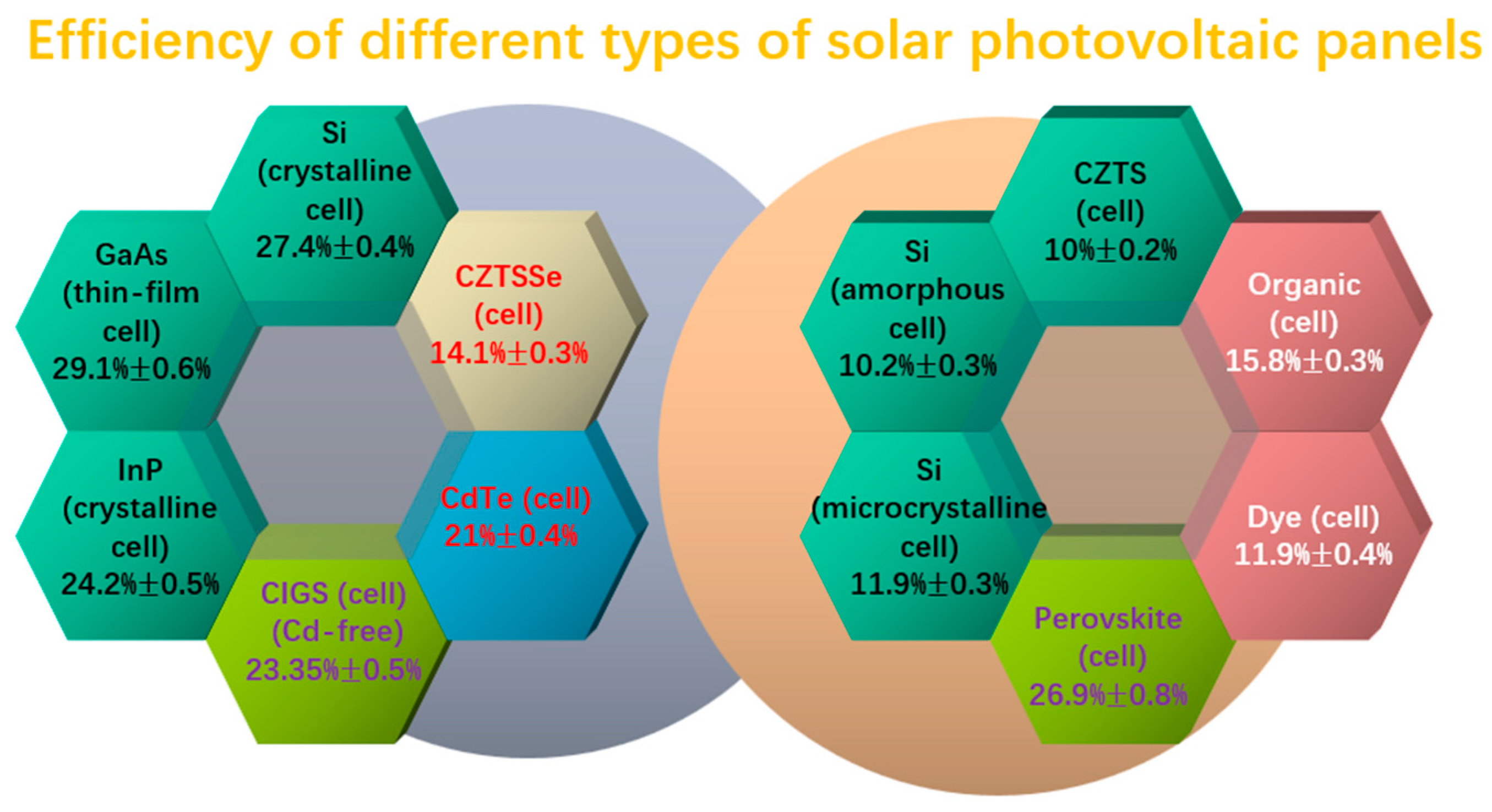
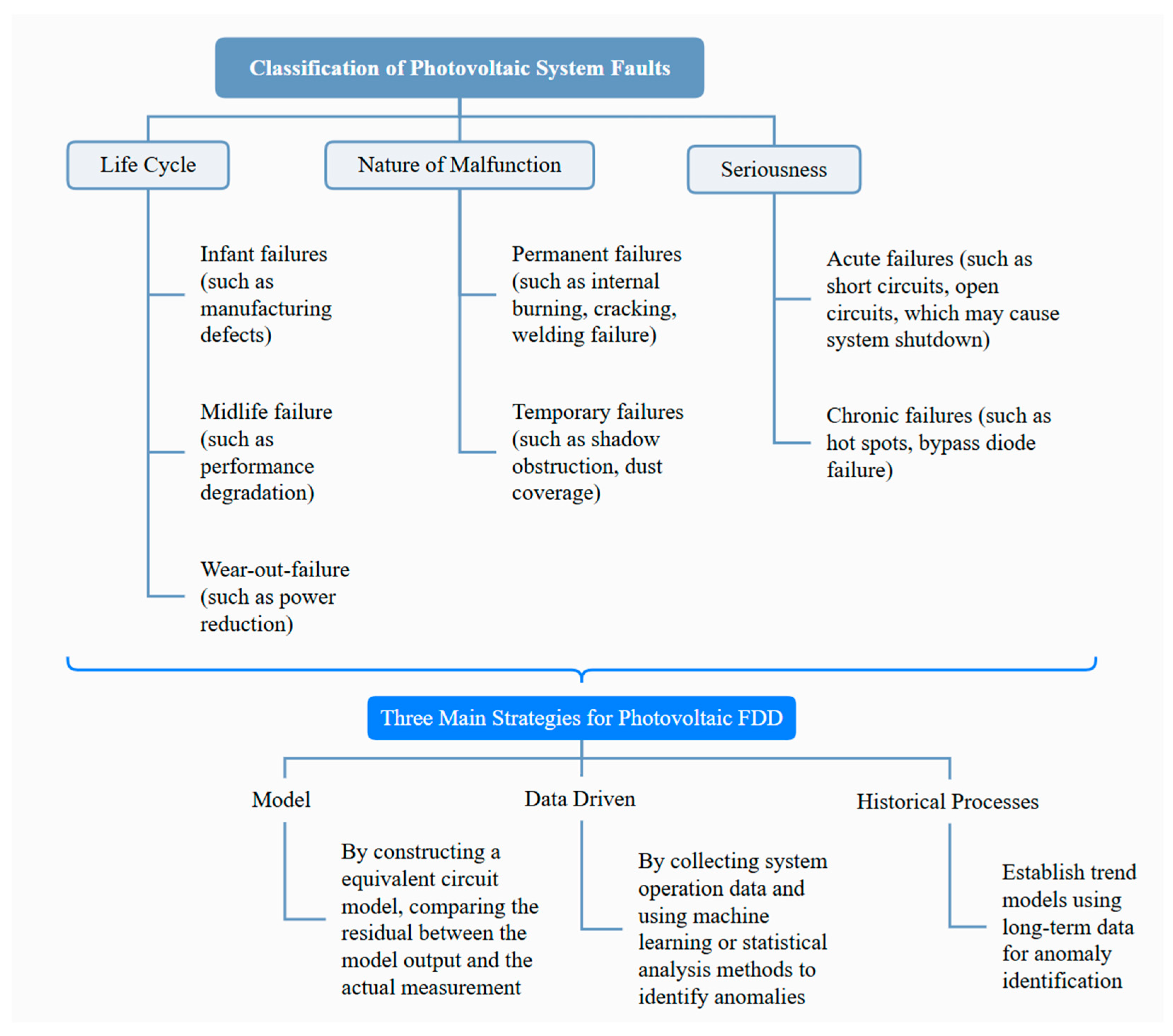
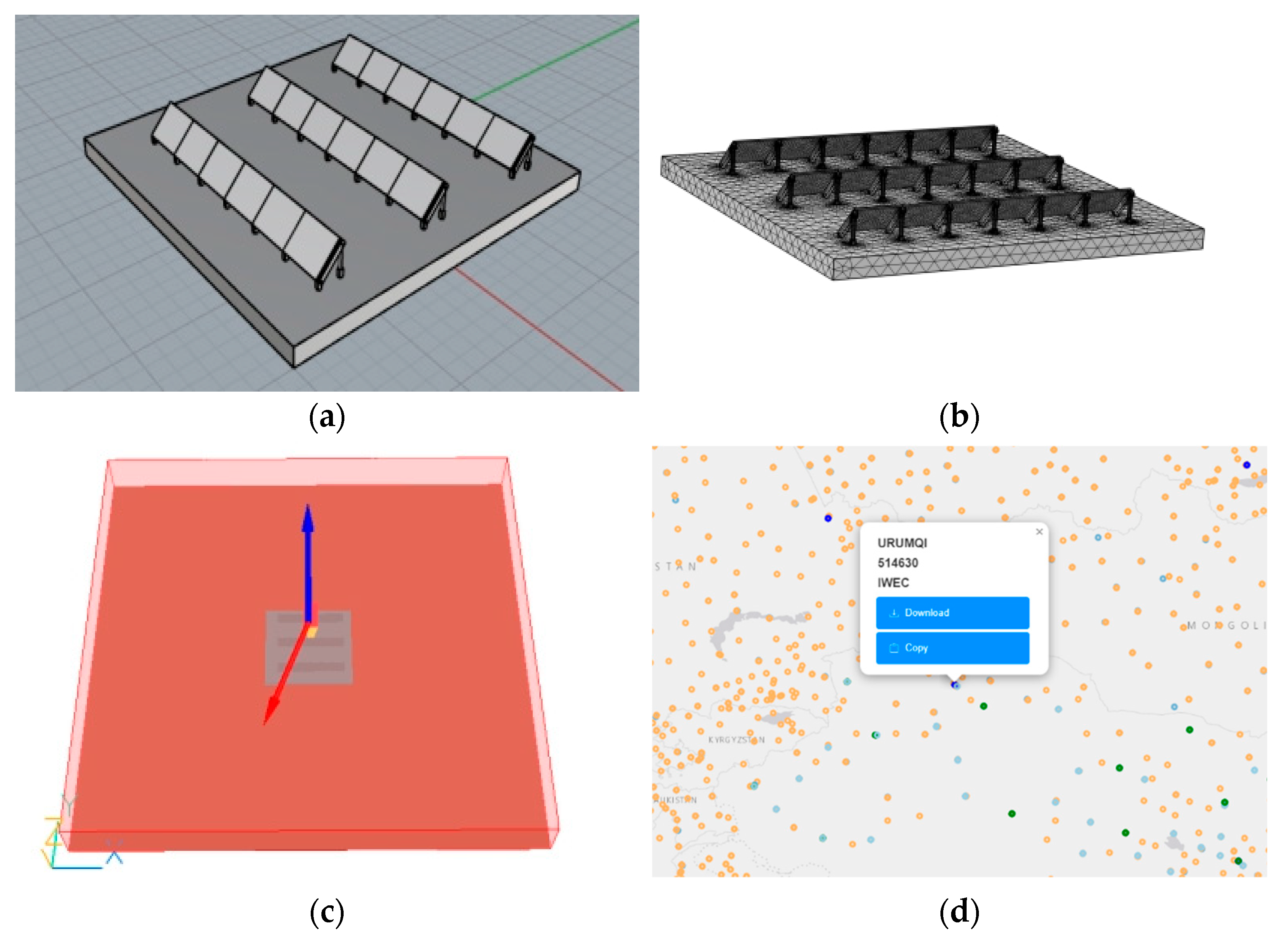


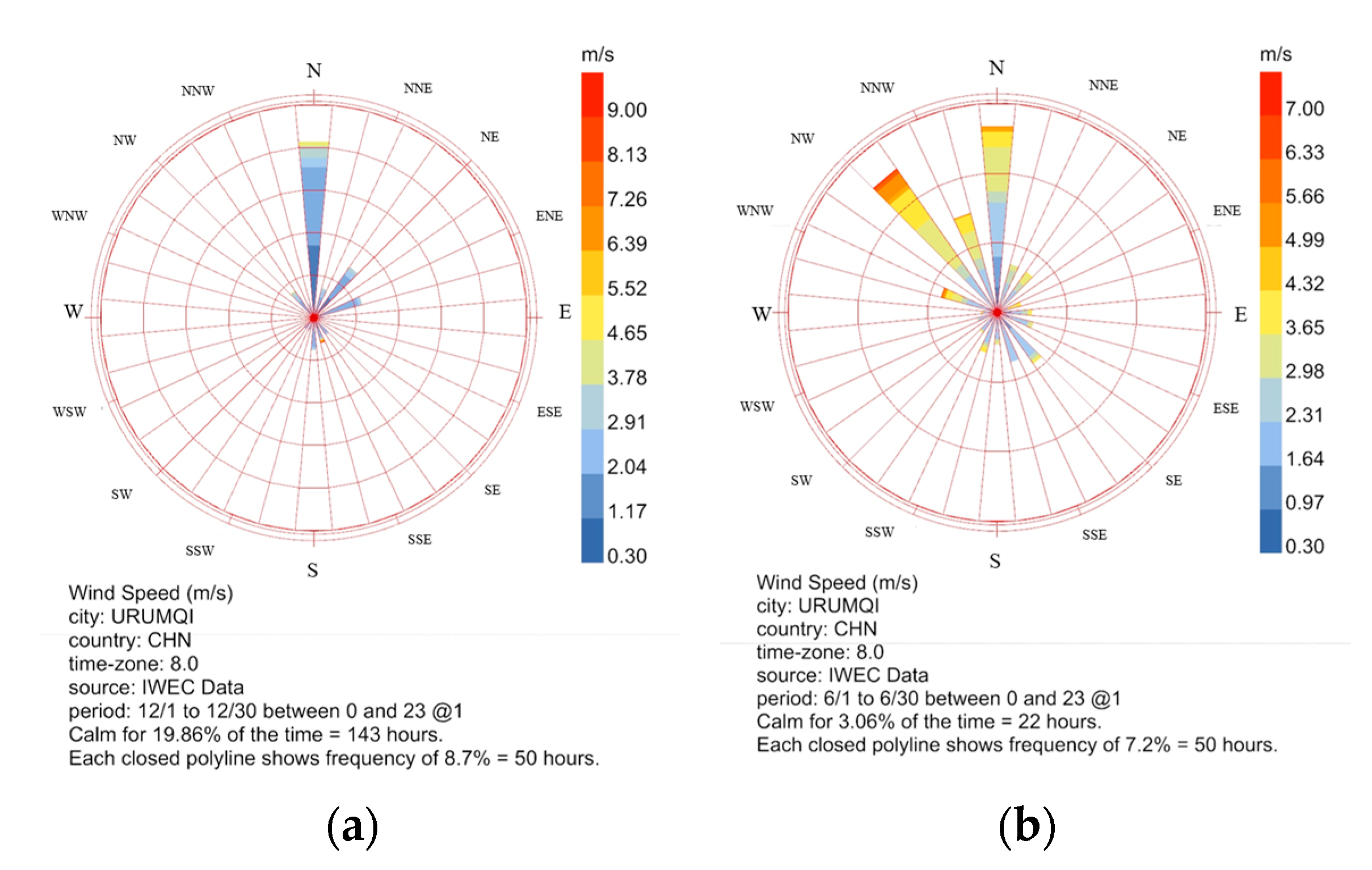
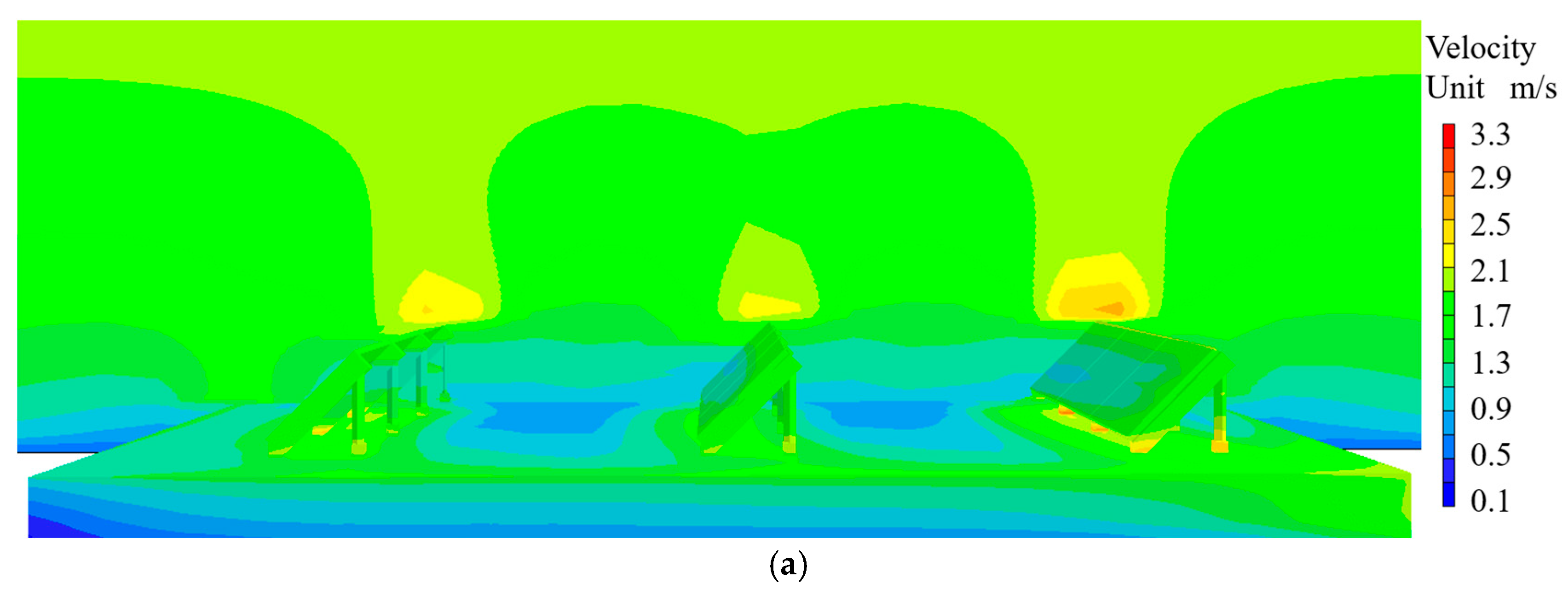
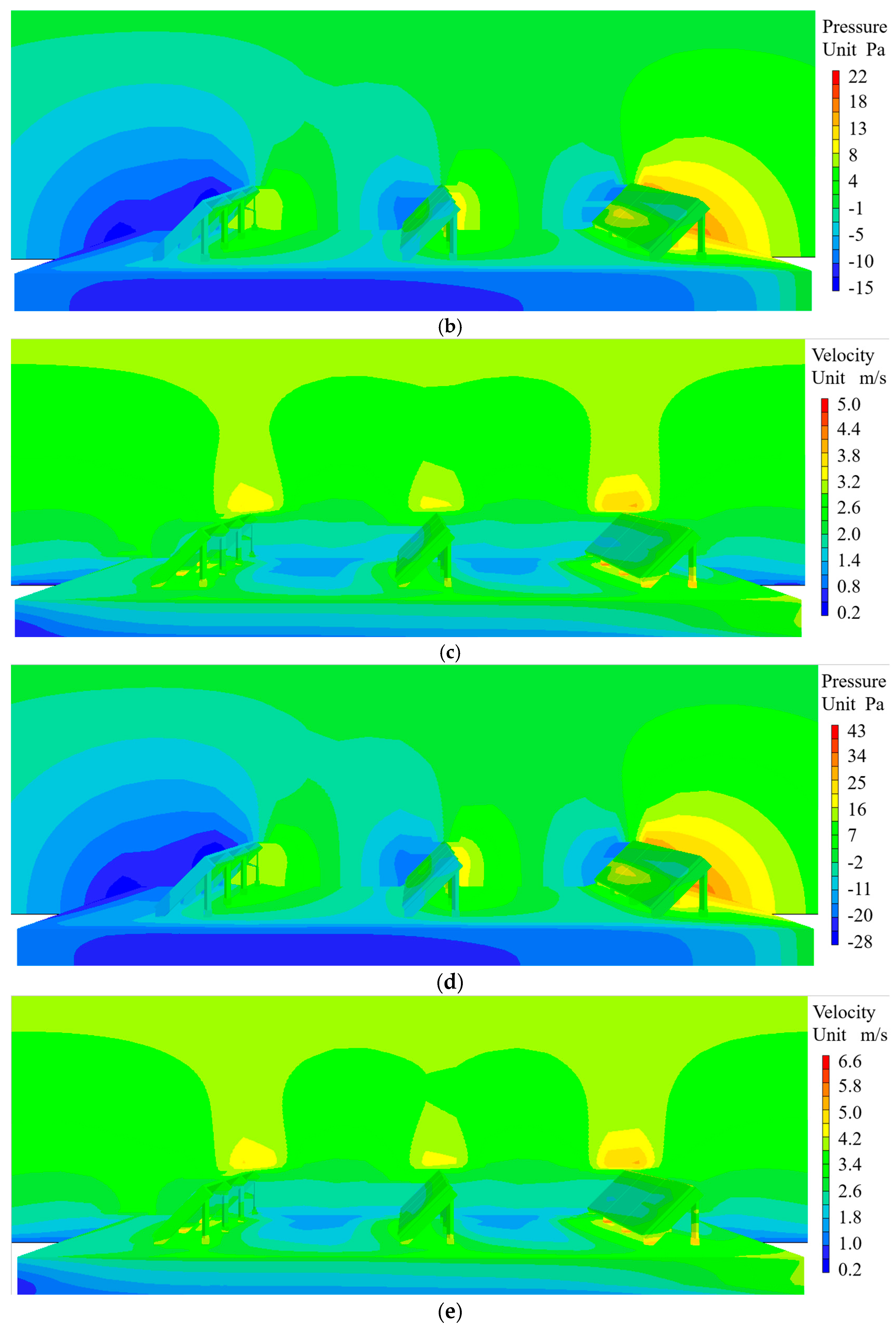

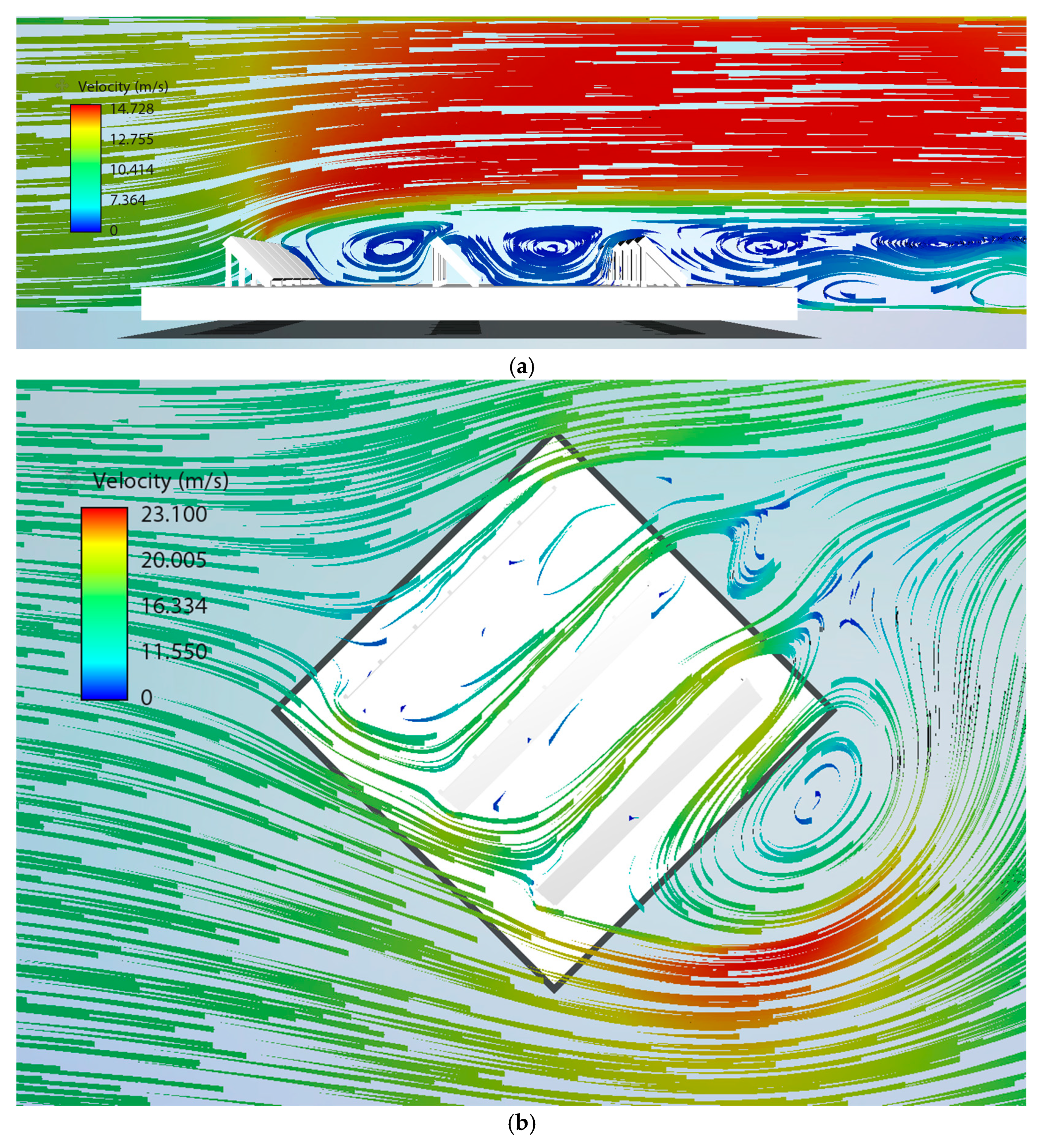
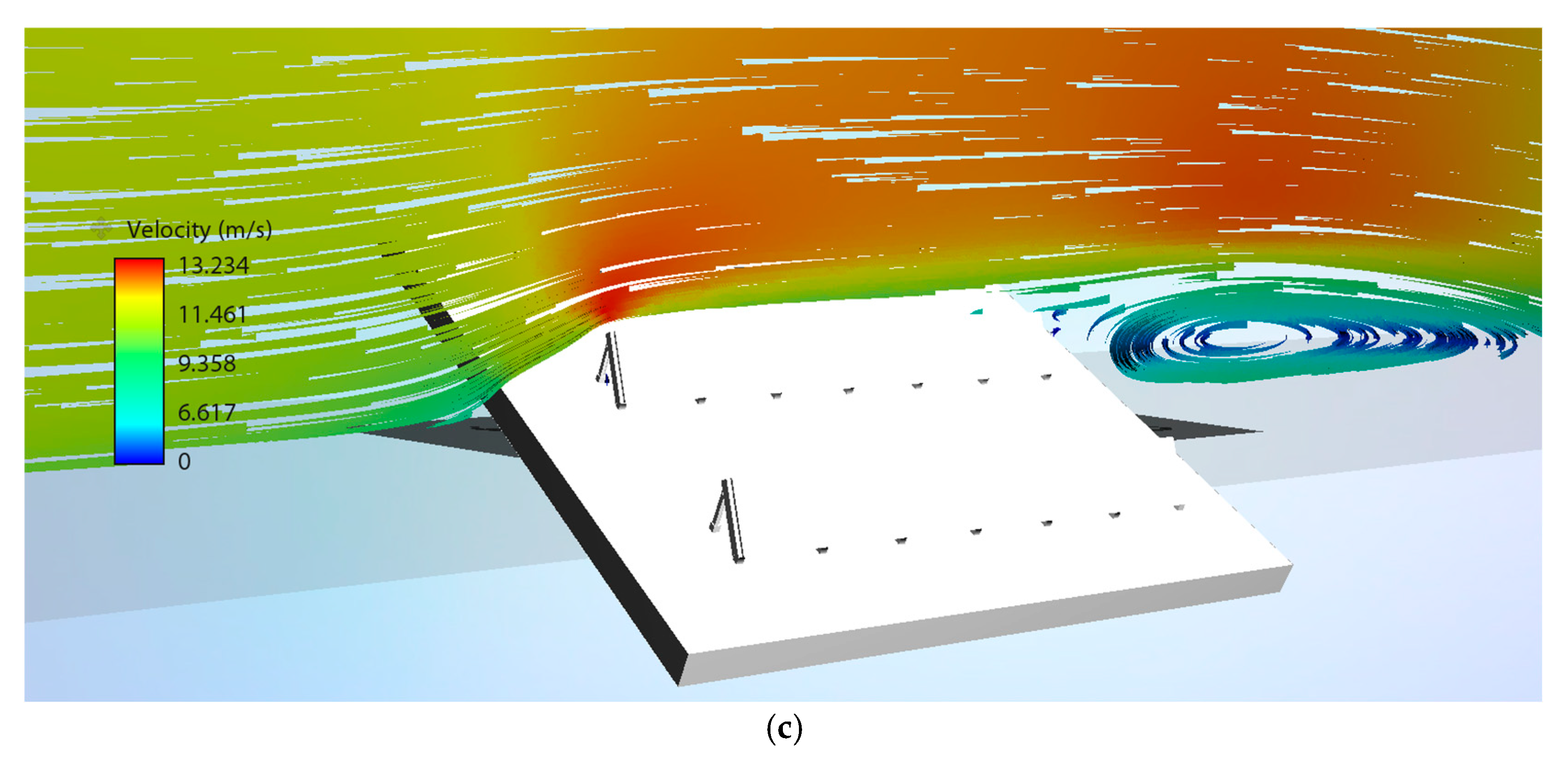
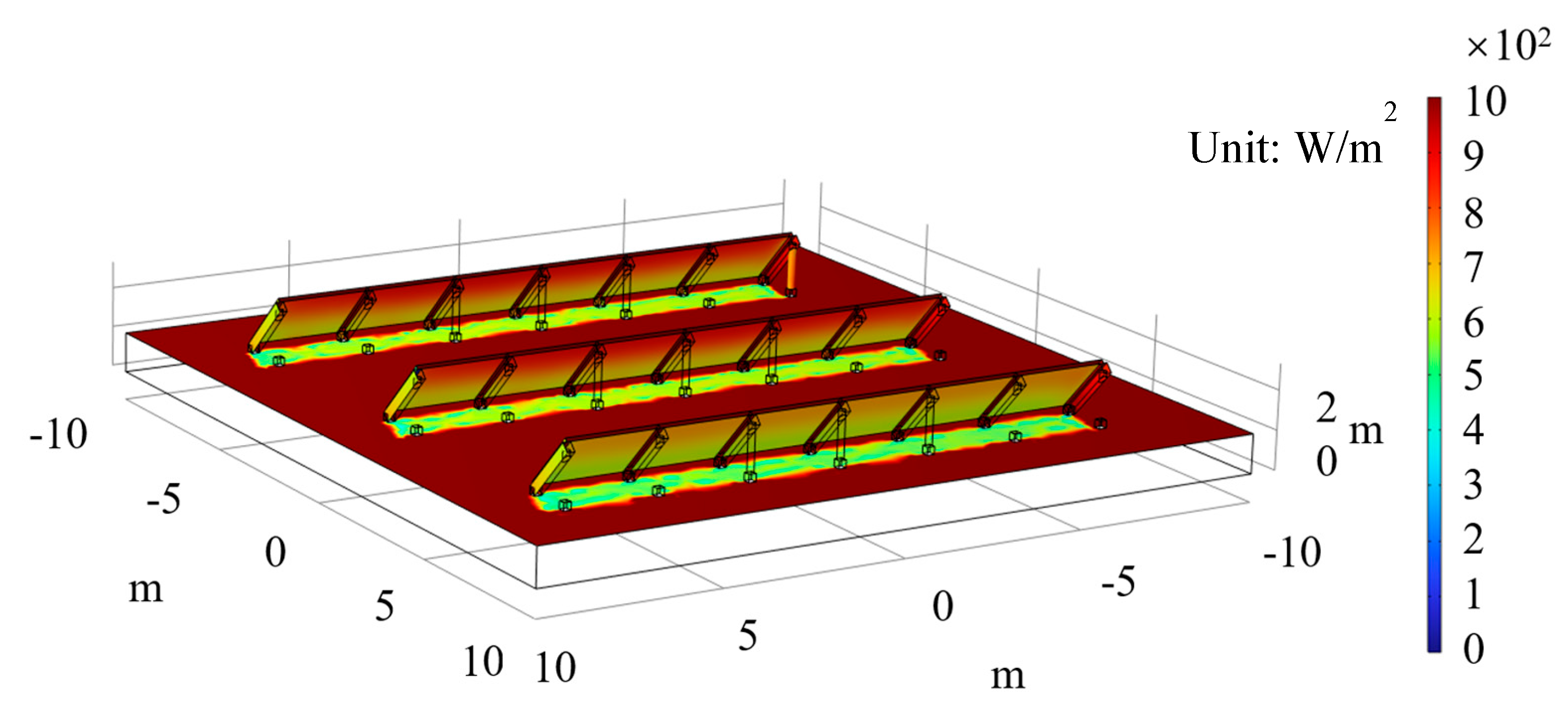
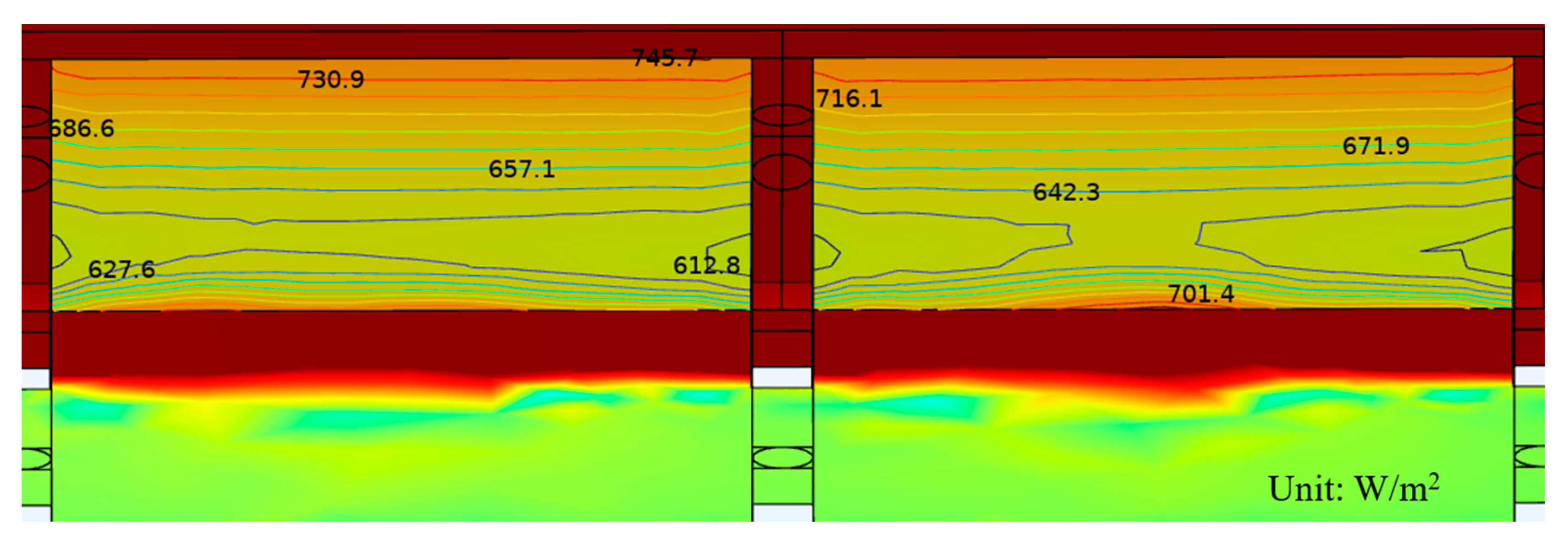
| Parameter | Value |
|---|---|
| Tilt angle of photovoltaic panel | 45° |
| Photovoltaic panel area | 8.75 m2 |
| Supporting structure | structural steel |
| Cell type | single-crystal silicon |
Disclaimer/Publisher’s Note: The statements, opinions and data contained in all publications are solely those of the individual author(s) and contributor(s) and not of MDPI and/or the editor(s). MDPI and/or the editor(s) disclaim responsibility for any injury to people or property resulting from any ideas, methods, instructions or products referred to in the content. |
© 2025 by the authors. Licensee MDPI, Basel, Switzerland. This article is an open access article distributed under the terms and conditions of the Creative Commons Attribution (CC BY) license (https://creativecommons.org/licenses/by/4.0/).
Share and Cite
Zhang, B.; Wang, B.; Zhang, H.; Outzourhit, A.; Belhora, F.; El Felsoufi, Z.; Zhang, J.-W.; Gao, J. Research on an Energy-Harvesting System Based on the Energy Field of the Environment Surrounding a Photovoltaic Power Plant. Energies 2025, 18, 3786. https://doi.org/10.3390/en18143786
Zhang B, Wang B, Zhang H, Outzourhit A, Belhora F, El Felsoufi Z, Zhang J-W, Gao J. Research on an Energy-Harvesting System Based on the Energy Field of the Environment Surrounding a Photovoltaic Power Plant. Energies. 2025; 18(14):3786. https://doi.org/10.3390/en18143786
Chicago/Turabian StyleZhang, Bin, Binbin Wang, Hongxi Zhang, Abdelkader Outzourhit, Fouad Belhora, Zoubir El Felsoufi, Jia-Wei Zhang, and Jun Gao. 2025. "Research on an Energy-Harvesting System Based on the Energy Field of the Environment Surrounding a Photovoltaic Power Plant" Energies 18, no. 14: 3786. https://doi.org/10.3390/en18143786
APA StyleZhang, B., Wang, B., Zhang, H., Outzourhit, A., Belhora, F., El Felsoufi, Z., Zhang, J.-W., & Gao, J. (2025). Research on an Energy-Harvesting System Based on the Energy Field of the Environment Surrounding a Photovoltaic Power Plant. Energies, 18(14), 3786. https://doi.org/10.3390/en18143786






